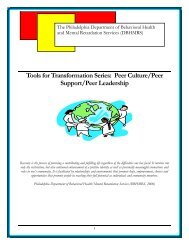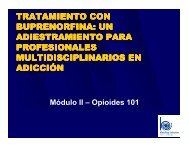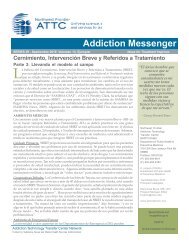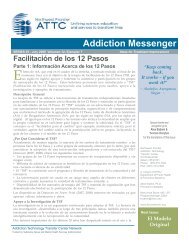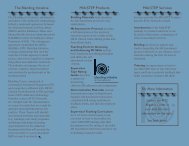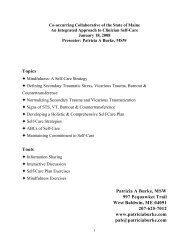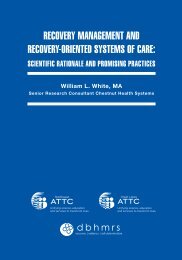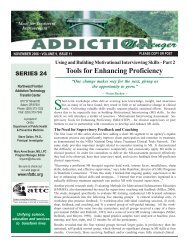alcohol and other drug problems among addiction professionals
alcohol and other drug problems among addiction professionals
alcohol and other drug problems among addiction professionals
You also want an ePaper? Increase the reach of your titles
YUMPU automatically turns print PDFs into web optimized ePapers that Google loves.
E x e c u t i v e S u m m a r yn n nSome issues draw attention because of their broad scope, <strong>and</strong> <strong>other</strong>s becauseof their depth <strong>and</strong> potential impact. In September, 2006 <strong>and</strong> March, 2007, thirtyleaders in the <strong>addiction</strong> field gathered in Greenville, South Carolina <strong>and</strong> Savannah,Georgia to grapple with an issue whose scope is still unknown <strong>and</strong> whose consequences,when they arise, can be devastating.“Alcohol <strong>and</strong> Other Drug Problems Among Addiction Professionals” was thetitle of the Symposium Series sponsored by Southeast Addiction Technology TransferCenter <strong>and</strong> facilitated by Terence T. Gorski. The participants, leaders from thestates of Georgia <strong>and</strong> South Carolina, found in one an<strong>other</strong> rich resources of passion,dedication, knowledge, experience, humor, <strong>and</strong> hope. In the topic they founda door to the very core of the field’s work: Effective, ethical, fair, <strong>and</strong> humane treatmentof human beings.The tendency of compassion to grow out of pain has led many people fromtroubled backgrounds to seek work in the helping professions. The <strong>addiction</strong> field’shistorical roots in recovery have given it higher concentrations of recovering staffthan most <strong>other</strong> helping fields. Escalating needs <strong>and</strong> dwindling resources haveraised the field’s levels of stress <strong>and</strong> fatigue <strong>and</strong> made it more <strong>and</strong> more difficultto find the time <strong>and</strong> the will for self-care. And society’s relentless stigmatization ofpeople with <strong>addiction</strong> has often distorted the field’s awareness of, <strong>and</strong> response to,the <strong>alcohol</strong> <strong>and</strong> <strong>other</strong> <strong>drug</strong> (AOD) <strong>problems</strong> that arise <strong>among</strong> its staff.When these <strong>problems</strong> are denied or mish<strong>and</strong>led, they can endanger or destroythe fragile recovery <strong>and</strong> well being of vulnerable clients; the careers <strong>and</strong> potentialof dedicated but struggling employees; the harmony <strong>and</strong> equilibrium of serviceteams <strong>and</strong> entire organizational cultures; <strong>and</strong> community perception of, <strong>and</strong> beliefin, the treatment organization, the treatment field, <strong>and</strong> recovery itself.When these <strong>problems</strong> are addressed in humane, effective, <strong>and</strong> situation-appropriateways, they can save lives, restore careers, preserve the effectiveness <strong>and</strong>integrity of the treatment organization, <strong>and</strong> make a powerful statement about thestrength <strong>and</strong> resiliency of recovery. At the first symposium, participants identifiedtwelve core needs that the field <strong>and</strong> its leaders must consider to craft effective responsesto these issues. They are as follows:n n





